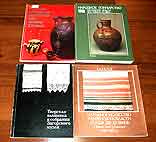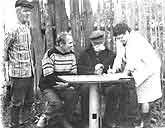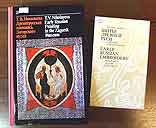History of the Scientific Research (page 3)
 At the next period there were published a number of serious catalogues of Tver embroidery (Kalmykova L.E. “Narodnaya Vyshivka Tverskoi zemli” (L., 1981) [“Folk Embroidery of the Tver Land”], Kalmykova L.E. “Tverskaya vyshivka v sobranii Zagorskogo muzeya. M., 1982. [Tver Embroidery in the Collection of the Zagorsk Museum]), folk art of the Penza Region (Zhiguleva V.M. Narodnoye iskusstvo penzenskoi oblasti. M. 1989. [Folk Art of the Penza Region.]), Dymkovo toys (Vodyaeva L.G. Dymkovskaya igrushka v sobranii Zagorskogo muzeya. M., 1981. [“Dymkovo Toy in the Collection of the Zagorsk Museum]).
At the next period there were published a number of serious catalogues of Tver embroidery (Kalmykova L.E. “Narodnaya Vyshivka Tverskoi zemli” (L., 1981) [“Folk Embroidery of the Tver Land”], Kalmykova L.E. “Tverskaya vyshivka v sobranii Zagorskogo muzeya. M., 1982. [Tver Embroidery in the Collection of the Zagorsk Museum]), folk art of the Penza Region (Zhiguleva V.M. Narodnoye iskusstvo penzenskoi oblasti. M. 1989. [Folk Art of the Penza Region.]), Dymkovo toys (Vodyaeva L.G. Dymkovskaya igrushka v sobranii Zagorskogo muzeya. M., 1981. [“Dymkovo Toy in the Collection of the Zagorsk Museum]).
 The catalogues of Kalmykova “Narodnoye goncharnoye iskusstvo XIX – nachala XX vv.”( M., 1976) [Folk Pottery of the 19th – early 20th century] and “Narodnoye goncharstvo Moskovskoi oblasti XIX – nachala XX vv.” (M., 1995) [The 19th – early 20th century Pottery of the Moscow Region], based on the expedition materials, gave valuable information about works of art, their function, craftsmen and centers of production
The catalogues of Kalmykova “Narodnoye goncharnoye iskusstvo XIX – nachala XX vv.”( M., 1976) [Folk Pottery of the 19th – early 20th century] and “Narodnoye goncharstvo Moskovskoi oblasti XIX – nachala XX vv.” (M., 1995) [The 19th – early 20th century Pottery of the Moscow Region], based on the expedition materials, gave valuable information about works of art, their function, craftsmen and centers of production
![Album “Chukotsko – eskimosskoe iskusstvo” (Fisinina A.K. L., 1981) [Chuckchee-Eskimo Art].](museum/kn5chukotka_m.jpg) A lot of information of the Museum art collections was presented in the album “Chukotsko – eskimosskoe iskusstvo” (Fisinina A.K. L., 1981) [Chuckchee-Eskimo Art], “Narodnoye iskusstvo Tverskoi zemli” (Kalmykova L.E., 1981) [“Folk Art of the Tver Land”]. The collection of cotton kerchiefs is of great scientific interest. It was published in the catalogue “Russian Calico Kerchiefs of the 19th – Early 20th Century from the Collection of the State History and Art Museum-Reserve in Sergiev Posad” (Gorozhanina S.V., Zhiguleva V.M., Zaitseva L.M. M., 1994).
A lot of information of the Museum art collections was presented in the album “Chukotsko – eskimosskoe iskusstvo” (Fisinina A.K. L., 1981) [Chuckchee-Eskimo Art], “Narodnoye iskusstvo Tverskoi zemli” (Kalmykova L.E., 1981) [“Folk Art of the Tver Land”]. The collection of cotton kerchiefs is of great scientific interest. It was published in the catalogue “Russian Calico Kerchiefs of the 19th – Early 20th Century from the Collection of the State History and Art Museum-Reserve in Sergiev Posad” (Gorozhanina S.V., Zhiguleva V.M., Zaitseva L.M. M., 1994).
 Alongside with folk art, they studied the ancient collections. These collections were investigated by Nikolayeva T.V. and Mayasova N.A., who left the Museum in the 1960s. In 1977, they published the catalogue of Nikolayeva T.V. “Eearly Russian Painting in the Zagorsk Museum” (M., 1977), presenting more precise attribution of the icons.
Alongside with folk art, they studied the ancient collections. These collections were investigated by Nikolayeva T.V. and Mayasova N.A., who left the Museum in the 1960s. In 1977, they published the catalogue of Nikolayeva T.V. “Eearly Russian Painting in the Zagorsk Museum” (M., 1977), presenting more precise attribution of the icons.
|


